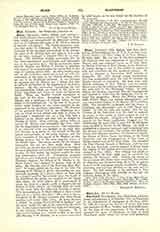

Blanc, ANTHONY, fifth Bishop, and first Archbishop, of New Orleans, La., U.S.A., b. at Sury, near Lyons, France, October 11, 1792; d. at New Orleans, June 20, 1860. He was one of the first ecclesiastical students after the restoration of the Church in France, and was ordained priest on July 22, 1816, by Bishop Dubourg of New Orleans, in the Seminary at Lyons, during a visit of that prelate in search of help and volunteers for the American mission. He came to America in September, 1817, landing at Annapolis, MD., with several young seminarians, and was entertained until the end of October by Charles Carroll at Carrolton. He then went with Bishop Dubourg to New Orleans and for nearly fifteen years led the arduous life of a missionary over the wide field of the Mississippi Valley. In 1831, Bishop De Neckere appointed him his vicar-general and wanted to make him his coadjutor, but he refused the promotion. When the Bishop died, in 1853, Father Blanc was named administrator, and was consecrated bishop of the diocese, November 22, 1835. His jurisdiction extended over the States of Louisiana and Mississippi, and in 1838 Texas was added. In 1842 he came into conflict with the lay trustees of the Cathedral over his right to appoint its rector, in the course of which contest he had to interdict the church. Litigation in the courts and appeals to the State Legislature dragged out the controversy for more than a year, but all the issues were decided in favor of the Bishop. In 1838 he established a diocesan seminary and introduced into the diocese the Lazarists, the Jesuits, the Redemptorists, the Christian Brothers, the Sisters of Charity, the Sisters of Notre Dame, the Sisters of the Good Shepherd, and the Congregations of Our Lady of Mount Carmel and of the Holy Cross. He attended the First Plenary Council of Baltimore, and was one of the few American prelates present in Rome when the dogma of the Immaculate Conception was proclaimed (December 8, 1854). New Orleans was made an archbishopric, July 19, 1850, and he received the pallium, February 16, 1851. During his tenure of the see many old abuses were corrected; the number of churches was increased from 26 to 73, of priests from 27 to 92, and many schools, academies, colleges, convents, and asylums testified to his zeal and labors. He died suddenly at his residence in New Orleans, discharging with activity to the last the arduous duties of his office.
THOMAS F. MEEHAN.

